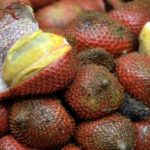
People tend to put premium on good looks. However, some of the most hard-featured looking
fruits happened to be the most appetizing, if not the tastiest. For
fruits, those that look good on the outside are usually given the first bite while those that are not are often overlooked. What’s more an ugly-looking, even utterly repulsive, fruit that no one even heard of? Take “
paratungon” for example.

Paratungon (
Salacca ramosiana Mogea) is a species of palm under the (family Arecaceae/Palmae). Its fruits grow in clusters at the base of the tree. The fruits are deep orange colored with prickly and scaly skin. They are about the size and shape of a ripe rambutan with a distinct tip at the base. The fruit can be peeled off by pinching the tip of the skin and pulling the peels away. The taste is usually sour but others say some varieties are sweet and acidic. The fruit is reported to be an endemic species in the
Philippines. It was first seen and recorded in the 1930s in the Sulu Islands and later was found growing in abundance in Palawan in the 1980s as recorded in the field by the renowned botanist, Dr. John Dransfield. The salak or snake fruit (Salacca zalacca), a popular commodity grown in Indonesia, Malaysia and Brunei, is a related species. Currently, this fruit is a nearly threatened species in Palawan according to a recent research project funded by the Bureau of Agricultural Research (
BAR) under its National Technology Commercialization Program (NTCP). The project titled, “Identification and Collection of Indigenous Fruits in Palawan” is being implemented by the
agriculture/" title="View all articles about Department of Agriculture here">Department of Agriculture- Regional Field Unit 4B which covers Marinduque, Mindoro Occidental, Mindoro Oriental, Palawan and Romblon (MIMAROPA), in collaboration with the Western
Philippines University (WPU). The project aimed to sustainably conserve in-situ the diversity of indigenous tropical fruit species through approaches that involve various stakeholders and the
promotion of public awareness and enhanced utilization of these plant genetic resources. The identified fruits are also being looked at for their commercial production and processing properties. Paratungon is one of the 47 indigenous tropical fruit species that were identified for their economic potential as food source. Other indigenous crops with economic potentials are: tabu (a vine that bears white flesh fruits), palau-biyok (a yellow or orange colored fruit), and luod or wild durian (juicy and sweet fruit with a very strong odor).
 Potential for wine making
Potential for wine making Still under the
BAR-
DA IVB-WSU research intiative,
paratungon was studied for its potential as a source for wine making and other by-products such as marmalades and champoy, among others. According to Dr. Romeo R. Lerom of WPU, the results of the study showed that the wine produced from paratungon has a very distinct aroma and taste which makes the paratungon fruit good for processing into wine. He added that paratungon is a non-seasonal fruit available all year round making it a continuous source of wine material. However, Dr. Lerom mentioned that since the technology is relatively new, he recommended that further studies be conducted to standardize the quality of the wine and the other products developed from paratungon. Likewise, it was recommended that appropriate tests be conducted to establish the nutritional composition of products from paratungon. Aside from these food products, other known uses of the plant are being explored, particularly the petioles and rachises (shaft) of the leaves as wall panel décor.
Salacca fruits In the Philippines, Salacca fruits are scarcely to be found, are hardly known, and remain underutilized. They are better known and appreciated in neighboring countries. The genus, Salacca, has 20 species of palms which are abundantly growing in Indonesia. The skin of the Salacca fruits has a unique snakeskin-like texture, which is mostly rough to the touch. The Salacca plant is typically a short-stemmed palm and its leaves have a spiny petiole. In most species they are pinnate with numerous leaflets, but some species, have undivided leaves. From the 20 species of Salacca, the “Salak” and the “Dalubi” are found in the country. These two were described and briefly discussed in the book, “Important and Underutilized Edible Fruits of the Philippines,” which was authored by Dr. Roberto E. Coronel, former professor at the University of the Philippines Los Baños (
UPLB). Salak (Salacca zalacca), commonly referred to as the “snake fruit”, is native to Indonesia and was introduced in some tropical countries. In the Philippines, it was introduced during the early 1900s but is rarely found now. The fruits are globose in shape, yellow and clothed with spiny scales. The flesh is shiny, translucent, yellow white, with a slight acidic taste, soft and encloses three dark brown, hard seeds. The fruit is often eaten raw. Another species, dalubi (Salacca clemensia) is said to be indigenous to the Philippines particularly in the low altitude areas of Mindanao. Fruits are in clusters, roundish and dark brown, and with scaly, shell-like peel in which are enclosed a rather scant, semi-transluscent, subacid, juicy flesh with 1-3 large seeds. The fruits may be eaten raw. Little is known of this underutilized species. ### Source: Rita T. dela Cruz BAR Digest October-December 2012 Issue (Vol. 14 No. 4)
Source: Business Diary Philippines



1 Comments
ReplyDeleteHello! Great article and thank You for Providing Such a Unique and valuable information on The PR Design for your readers. I
really appreciate it. You can also visit Italian Wine Montmorency for more Craft and Vine related information and knowledge.